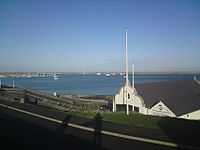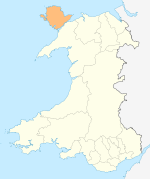Holyhead Breakwater

Holyhead Breakwater is situated at the north-western end of Holyhead on the island of Anglesey in North Wales. The Victorian structure, which is 1.7 miles (2.7 km) long, is the longest breakwater in the United Kingdom.[1] The breakwater, which is accessible in good weather, has a promenade on top which leads out to the Holyhead Breakwater Lighthouse.[1]
Construction
The purpose of the project was to enclose more than 400 acres (160 ha) of deep water to create a sheltered roadstead, in addition to Holyhead's pre-existing 276 acres (112 ha) harbour.[2] In 1848 the Chester and Holyhead Railway opened, dramatically increasing the amount of sailings between Ireland and Great Britain.

Work began in 1845 under the auspices of superintendent engineer J.M. Rendell.[1][2] Following his death in 1856, the project was completed by John Hawkshaw.[2]
Up to 1,300 men were employed during the project, of whom more than forty lost their lives.[3] Shaped 10-tonne blocks of limestone were used to create an outer facing wall, thereby encasing a rubble mound raised from the sea both by dumping from ships and tipping from the shore.[4] Divers in submarine bells created the level foundations on which the tiers of facing stones were placed.[5] These men worked underwater using picks and hammers, and carried out blasting using gunpowder sealed in watertight tin pipes.[5]
A broad gauge railway was used to carry more than seven million tonnes of stone from the quarries on Holyhead Mountain to the working areas.[1] The line eventually reached 1.48 mi (2.38 km) in length. In 1913 it was finally converted to standard gauge when a new engine was required, as the mid-1800s original had worn out.[6][7] Thanks to this, and a further transition to diesel traction (including the lightest standard-gauge shunters ever used on the British railways), the line continued in service for breakwater maintenance purposes until the 1980s, when it finally ceased operations and maintenance duties were taken over by various road and all-terrain vehicles.[8]
The breakwater, which took 28 years to complete, was officially opened on 19 August 1873 by Albert Edward, Prince of Wales.[1]
Gallery
|
Notes
- ↑ 1.0 1.1 1.2 1.3 1.4 Denton, A., & Leach, N. (2008). Lighthouses of Wales. Landmark Publishing Ltd. ISBN 978-1-84306-459-6.
- ↑ 2.0 2.1 2.2 Cragg, Roger (1997). Civil Engineering Heritage Series: Wales & West Central England. Thomas Telford. pp. 7–8. ISBN 0727725769.
- ↑ Hughes, Margaret (2001). Anglesey from the Sea. Carreg Gwalch. ISBN 0-86381-698-3.
- ↑ Smith, Mick R. (1999). "Stone: Building Stone, Rock Fill and Armourstone in Construction". Geological Society Engineering Geology Special Publication 16: 296. ISBN 1862390290.
- ↑ 5.0 5.1 Jamieson, Alexander (1879). Dictionary of Mechanical Science, Arts, Manufactures, and Miscellaneous Knowledge, Volume 1. H. Fisher, Son & Company. p. 103.
- ↑ History of Rail Transport in Great Britain. PediaPress.
- ↑ Jones, Geraint I.L. (2005). Anglesey Railways. Carreg Gwalch. ISBN 1-84527-006-1.
- ↑ "Holyhead Breakwater". http://www.2d53.co.uk/. Retrieved 20 March 2013.
Coordinates: 53°19′30″N 4°37′48″W / 53.325°N 4.63°W
| ||||||||||||||||||||||||||||








